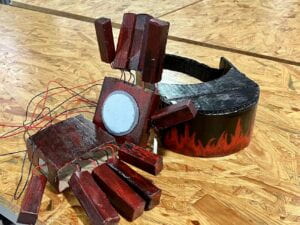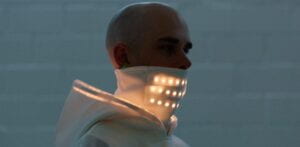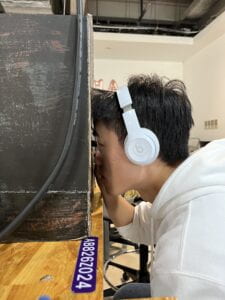A. Project Information
Reviving
– Ruilin & Xiao
– Rudi
B. Context and Significance
Speaking of how my previous research impacts or inspires my midterm project, I believe it is the concept of invisibility and imagination. In group project, we’ve designed a headset and a pair of sensory gloves, simulating the VR devices. Of course, when users actually put on the prototype, they have no access to the advanced technology of VR according to our settings. Thus, in our performance, we triggered the imagination of the audience by visualizing this “invisibility”. As a matter of fact, that concept further embodies in my midterm project. Xiao and I “hide” our actual project into a “dark cave”, making the content partly invisible if users merely observe from the outside. And that invisibility arouses the curiosity and imagination of the users, leading them find out what exactly is in the “cave”.


(group project)
Besides, I would like to talk about how my previous researches trigger my understanding of interaction. My definition of interaction, as written in the Group Project-Research, is: a cyclic process, which is usually presented through the form of conversation, allows two parties to input, process and output information in a relatively equal position. In my group project, the device will detect the emotions of the users(input), evaluate them and choose a vivid virtual scene for us(process), and finally present them through offering us four senses(output). Consequently, the users receive the given four senses(input), engage in them(process), and alleviate their negative emotions(output). Besides, I want to talk about one similar project I’ve seen during my research, which is an emotion sensing clothing. The clothing lights up(output) according to the wearer’s mood(input, process), thus calming the mood(output) of autistic toddlers(input, process) (Fran, 2017).

(emotion sensing clothing)
Back to my midterm project, I do think our project bears some uniqueness and significance. On one hand, the uniqueness lies in the idea mentioned above: we created a process of exploration of the cave, making our project more intriguing and interesting. On the other hand, the significance lies in our intention of designing this project: we’ve heard about the sad news that the marvelous Dunhuang Grottoes paintings, which is located in Northeastern China will be destined to fade with time because of the terrible weather condition and local environment. Thus, we want to revive the painting using modern technology, paying a tribute to our ancestors, as well as trying to find a way which reflects our hope of the long-lasting preservation of historical relics. and promote our fine Chinese traditional culture to fellow classmates, who come from different countries and cultural backgrounds.
As for the intended audience of my project, I believe the students in NYUSH perfectly match our intention, since they come from different countries and cultural backgrounds. I believe it’s a great opportunity to promote our fine Chinese traditional culture to them, and also publicize the awareness of preserving cultural relics.
C. Concept and Design
In terms of my understanding of how my users were going to interact with my project, I hope their interaction is based on their immersion in the story and the curiosity which drives them to move the story forward, unconsciously creating a simulation of exploring a cave. Therefore, we’ve made several decisions. To start with, we utilized some cues to silently guide them, such as written words “pick up a torch” and “follow the specific signs”. What’s more, we wrote the background of the story on the “wall of the cave” in order to deepen the users’ understanding of the storyline. In addition, to make the scene more vivid, we made the characters in the story move and highlight their presence, thus adding some motors and LEDs. Above all, the most important element of our project is the torch, which added a brilliant touch to the theme we want to express. The criteria to select the torch is its close connection to “cave exploration”. We did think about using the flashlight of the phone, but we gave it up since it was not immersive enough.

(idea and concept)
Other materials we use were the Neopixel Strip and some cotton, in order to simulate the effect of the sun and the cloud. We once considered using some LEDs, but it doesn’t work as well as the Neopixel Strip, since we cannot alter the color and the brightness of the light. After all, the light yellow is more similar to sunlight. And to our surprise, the color added some sacred atmosphere to the “cave”, which couldn’t be better.
On top of that, Xiao drew some characters in the story the Nine-colored Deer on some A4 paper, and then stuck them on the cardboard. The characters are also in line with the story.


(the characters)
D. Fabrication and Production
We do have some significant steps in our production process. Among them, our successes lie in connecting the circuit (The wires were originally in a mess and constantly fell off, but we successfully reorganized them), writing the code(including changing “delay” to “millis” and altering the rotation speed, both of which took us a long time to adjust and try), and supporting the Neopixel Strip which stuck on the wall of the cardboard cave. However, we still experienced some failures, including failing to find the best way to stabilize the cardboard characters, especially the part of the mountain and palace.




(the process of production)
As for my personal contribution, I brainstormed with my teammate Xiao, wrote part of the codes, cut and glued the cardboards, soldered the LEDs, light sensors and servos, and wrote the background story in the English version.

Overall speaking, Xiao and I had an really great cooperation. Before we started working every time, we would briefly discuss together, make plans for the day, and then distribute our work. However, having strict schedules doesn’t mean the lack of flexibility. Whenever Xiao or I came up with a better idea, we’re more than willing to listen to each other’s opinion and dig deep into the feasibility, sharing a common goal of making our project better.


During the User Testing Session, we let other students and learning assistants test our semi-finished project. According to their feedback, we realized that we hadn’t provided our users with clear direction of how to interact with our project, and that our users seemed to be confused about what we were trying to express since we hadn’t come up with how we should present the story and the initiative to them. We did reflect on these problems and made some effective adaptations.

(users testing)
To begin with, it wasn’t until the user testing session did we come up with the idea of making a “cave”. Instead, what we had originally thought about was a stage. But since our project is largely related to the Dunhuang Grottoes, making it a cave is more reasonable and intriguing.
Moreover, we designed some cues to guide our users and improve their experience of interaction. Specifically, we wrote on the wall outside the cave to remind the users to utilize a torch to “start their adventure”, and marked the places where the torch should point. These are meant for enhancing the experience of cave experience and ensuring the process to go smoothly, which are in accordance with our project goals.
Finally, to order to inform our users about the background story, namely the Nine-colored Deer, we also wrote a few lines about the summary on the cave, and call our users “the adventurers”.
Attached below is our codes:
const int LIGHT_SENSOR1_PIN = A0;const int LIGHT_SENSOR2_PIN = A1;const int LIGHT_SENSOR3_PIN = A2;const int LED1_PIN = 3; // Arduino pin connected to LED's pinconst int LED2_PIN = 5;const int LED3_PIN = 11;const int ANALOG_THRESHOLD = 500;bool runChecker = false;unsigned long timePrevious = 100000;bool runChecker2 = false;unsigned long timePrevious2 = 100000;int brightness = 0; // how bright the LED isint fadeAmount = 20; // how many points to fade the LED by#include <Servo.h>Servo servo;int d = 500;void setup() {Serial.begin(9600);pinMode(LED1_PIN, OUTPUT); // set arduino pin to output modepinMode(9, OUTPUT);pinMode(LED2_PIN, OUTPUT); // set arduino pin to output modepinMode(10, OUTPUT);pinMode(LED3_PIN, OUTPUT); // set arduino pin to output modepinMode(13, OUTPUT);}// variables will change:int analogValue;void loop() {analogValue = analogRead(LIGHT_SENSOR1_PIN); // read the input on analog pindelay(100);Serial.println(analogValue);if(analogValue > ANALOG_THRESHOLD){analogWrite(LED1_PIN, brightness);// change the brightness for next time through the loop:brightness = brightness + fadeAmount;// reverse the direction of the fading at the ends of the fade:if(brightness <= 0 || brightness >= 100){fadeAmount = -fadeAmount;}// wait for 30 milliseconds to see the dimming effectdelay(30);servo.attach(10);if(runChecker == false){timePrevious = millis();runChecker = true;}if(millis()-timePrevious<1000){servo.write(60);Serial.println('a');}if(millis()-timePrevious>1000 && millis()-timePrevious<2000){servo.write(120);Serial.println('s');}if(millis()-timePrevious>2000){runChecker = false;}}else{digitalWrite(LED1_PIN, LOW); // turn off LED}analogValue = analogRead(LIGHT_SENSOR2_PIN); // read the input on analog pindelay(100);Serial.println(analogValue);if(analogValue > ANALOG_THRESHOLD){analogWrite(LED2_PIN, brightness);// change the brightness for next time through the loop:brightness = brightness + fadeAmount;// reverse the direction of the fading at the ends of the fade:if(brightness <= 0 || brightness >= 100){fadeAmount = -fadeAmount;}// wait for 30 milliseconds to see the dimming effectdelay(30);servo.attach(10);if(runChecker == false){timePrevious = millis();runChecker = true;}if(millis()-timePrevious<1000){servo.write(60);Serial.println('a');}if(millis()-timePrevious>1000 && millis()-timePrevious<2000){servo.write(120);Serial.println('s');}if(millis()-timePrevious>2000){runChecker = false;}}else{digitalWrite(LED2_PIN, LOW); // turn off LED}analogValue = analogRead(LIGHT_SENSOR3_PIN); // read the input on analog pindelay(100);Serial.println(analogValue);if(analogValue > ANALOG_THRESHOLD){analogWrite(LED3_PIN, brightness);// change the brightness for next time through the loop:brightness = brightness + fadeAmount;// reverse the direction of the fading at the ends of the fade:if(brightness <= 0 || brightness >= 100){fadeAmount = -fadeAmount;}// wait for 30 milliseconds to see the dimming effectdelay(30);servo.attach(13);if(runChecker == false){timePrevious = millis();runChecker = true;}if(millis()-timePrevious<1000){servo.write(60);Serial.println('a');}if(millis()-timePrevious>1000 && millis()-timePrevious<2000){servo.write(120);Serial.println('s');}if(millis()-timePrevious>2000){runChecker = false;}}else{digitalWrite(LED3_PIN, LOW); // turn off LED}}(the final outcome of our project)
E. Conclusions
The goal of our project is to share a classic Chinese myth through interaction and visual art, promote traditional Chinese culture and to raise the awareness of historical relics conservation while exhibiting a visual artifact.

(the Dunhuang Grotto of the Nine-colored Deer)
On one hand, my project results align with my definition of interaction by providing multiple ways for users to have “conversations” with the project and be engaged in the story, creating cyclic processes which allow two parties to input, process and output information in a relatively equal position.
On the other hand, to some extent, my project results fail to align with my definition of interaction. Honestly, a long text written on our project seems to have directly given our users too much information, thus lacking certain interaction.

(how our project looks like when seeing from outside)
Ultimately, how my audience interact with my project was completely in line with our expectation and definition of interaction. They were first curious about what was hidden inside the black cave, thus starting making interaction. Consequently, the more interaction they made, the more information they would get from the project, and the more character movements they would be able to “unlock”.


Were I given enough time to finish the project, I would use voice prompt instead of writing a long text outside of the box. Besides, I would try to make the movement of the character more vivid, such as making the deer actually move its legs and run.
On top of the result of my project, I would like to talk about my own experience and growth during this midterm project. Actually, the whole process of designing and fabricating was not always going smoothly. But whenever encountering difficulties which were beyond my current ability, I never hesitate to seek help and actively learn from others, including the professors and my fellow classmates (special thanks to Steve Lu, who has always been helpful and patient :D). And it is the learning process that deepens my understanding of Arduino, enriches my knowledge about fabrication, and most importantly, I genuinely gains a sense of achievement after finishing the whole project.

(me & the learning assistant Kaylee)
To conclude, let’s move back to our project. Why do it and the idea behind it matter? I want to reflect on this question from two perspective. In terms of the importance of the idea, I want to express more than merely just a visual artifact. In fact, I do think the awareness of relics preservation should be taken seriously in our times, especially in such an era where technology is unprecedentedly powerful. Therefore, we try to “revive” the fading relics in the form of modern technology, achieving a perfect combination of history and future. Better still, the multicultural atmosphere in NYU Shanghai is positively encouraging us to promote our Chinese culture; As for the form of our project, the size of the view entrance limits the number of audience who can interact with the project at the same time. In other words, exclusively one person at a time can be the “cave adventurer”. I believe that we were actually thinking outside the box, thus creating something unique and novel, from which I get a real sense of achievement.

(the final outcome of our project)
REFERENCE
Emotion sensing clothing wins National Young Design Award. UNSW Sites. (n.d.). Retrieved October 16, 2022, from https://www.unsw.edu.au/news/2017/06/emotion-sensing-clothing-wins-national-young-design-award
The analysis and photo of the story the Nine-colored Deer: https://zhuanlan.zhihu.com/p/368639310